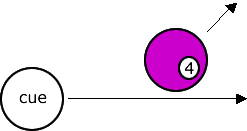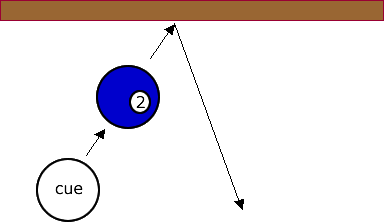2. LEARN THE LINGO
re are tons of pool terms out there, and we're not going to bore you with all of them; we'll just give you the basics so you can follow a standard game with your drunk friends. Believe us: memorizing this list of pool vocabulary will be worth the effort. Print it out and wear it around your neck. (Just don't carry it into the pool hall unless you actually want to get beat up, dork.)
Billiards vs. Pool
"Billiards" and "pool" are not the same thing. "Billiards" refers to all cue sports, including pool, carom (a game that involves a pool table with no pockets), and snooker (a British version of pool); however, pool is a specific type of billiards game. Use this useless tidbit of knowledge to intimidate your opponents.
- Cue ball: The white ball. It's the only ball that the cue is allowed to touch. Ever.
- Object ball: The first ball that the cue ball hits.
- Break: The break occurs at the very beginning of a game. When a game starts, somebody has to hit the cue ball first, sending into the neatly racked colored balls. This first hit is called the "break." You can also use it as a verb (as in, "Whose turn is it to break?").
- Pocketing a ball: Getting a ball into a pocket; pocketing a ball is also known as "sinking" a ball.
- Scratch: While you want to get your own balls into the pockets (we'll get to the rules of the game later), you NEVER want to get the cue ball or your opponent's balls into a pocket. Whether you do it on purpose or by accident, whenever you hit the cue ball or an opponent's ball into a pocket, you have "scratched" and will be penalized. By the way, you also scratch if you hit the cue ball, but it completely misses hitting any balls.
- Frozen: When an object ball is directly touching another ball or the wall of the table. These balls can be tough to hit properly. In the example below, the 6-ball is frozen.

- Position play: This is the act of hitting the cue ball with the necessary speed (and spin, if needed) to get the cue ball to end up someplace on the table where you'll be able to get the next ball in easily. In short, it's the strategy of thinking ahead and setting up your next shot.
- Hustler: A hustler is someone who goes into a pool bar pretending to suck, finds some losers that really do suck, and then tries to trick the losers into betting huge amounts of money on a pool game. A hustler will miss easy shots on purpose during a low-stakes game, and then when the losers offer to bet big money on another game, the hustler will "miraculously" kick ass and take the losers' money.
Some fancy moves
There are all kinds of fancy moves you can do when hitting the cue ball into an object ball. Here are some examples:
- Cut: When you hit a cue ball squarely into an object ball, the object ball will move in a straight line. However, if you cut, that means that you hit the cue ball so that it hits the object ball on the side, allowing the object ball to travel at an angle. In the example below, the cue ball hits the 4-ball at an angle, so that it cuts to the left.

- Banking a shot: This is when you hit the cue ball, the cue ball hits an object ball, and the object ball bounces off a wall of the table. If you can bank a shot into a pocket, it means that you are good or lucky. Below is an example of a bank shot: the cue ball hits, the 2-ball, which bounces off the wall and continues (hopefully into a pocket).

- Combination: This is when you hit the cue ball into an object ball, which in turn hits a second object ball (on purpose). Below, the cue ball hits the 15-ball, which in turn hits the 1-ball.

- Draw: You don't have to hit the cue ball square in the middle; if you like, you can hit the cue ball towards the bottom, creating spin. That way, when it hits the object ball, the cue ball will roll back towards you. This is called draw.
- Topspin: an effect that makes the cue ball spin forward at a greater rate of spin than if it were rolling naturally.
- English: This is when you hit the cue ball on the right or left side so that it spins.

